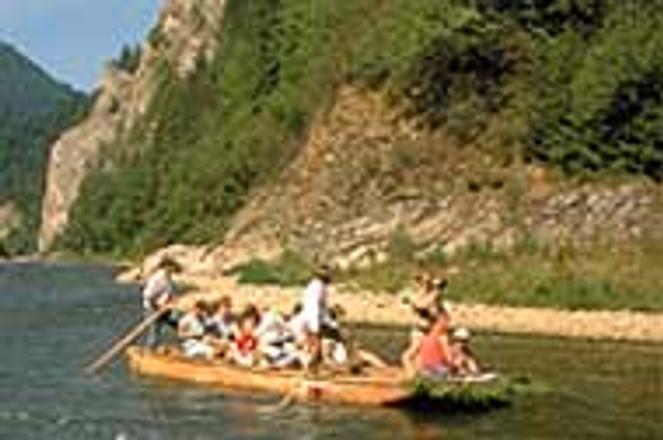Goral guides " pole" eager rafters through The Dunajec River Gorge along the Polish - Slovak borderphoto: Visual Collection
Tucked away to the northeast of the Tatras and snuggled up against Poland, Slovakia's most compact national park is easily overlooked. In Pieniny, the river Dunajec has cut out a canyon with 80-meter-high rock walls, a watery corridor that forms the border between Slovakia and Poland. The Three Crowns mountain dominates the view to the Polish side, and cradles Červený Kláštor (the Red Monastery) in its rocky arms.
14th century Carthusian monks, who hailed from the present-day Yugoslav territory, were given the plot of land by a Levoča nobleman to establish a community for contemplative thought and study.
Shut away in the monastery, the Carthusians were one of the strictest hermitic orders and lived in seclusion, silence, fasting, prayer and meditation, with only basic living quarters and minimal possessions save their libraries of laboriously copied and illustrated manuscripts. All of this plus their long white habits, which became more elaborate as the order evolved, are on display in a fascinating museum in the monastery.
Harsh living often brings out some bizarre human quirks, and the inhabitants of the Red Monastery were no exception. In the 15th and 16th centuries the Carthusian general chapter had to curb the monks' fanatic interest in astrology and alchemy, their search for the Elixir of Life which would make everybody happy. Prior John of Transylvania was relieved of his duties at a sister monastery, Skala útočišťa (the remains of which are being excavated by archaeologists at Kláštorisko in Slovenský Raj), after his mysterious experiments destroyed the property of his fellow monks.
The monastery declined until the 18th century, when it was occupied again by an order of hermits. A famous monk at the time, Brother Cyprián, delved into intriguing sciences once again. He collected medicinal plants from Pieniny and the Tatras, cataloguing the healing plants in Greek, Latin, German and Polish. He took his knowledge to the villages, curing people. As well as pharmacy, medicine and surgery, Cyprián also dabbled in alchemy, mechanics and cosmology and is said to have constructed a flying machine which he apparently flew to the Eastern Tatras. Remember, this was the late 18th century.
The Dunajec : Relaxing rafting
Log rafts tow up to 20 tourists with a folk-dressed guide down the Dunajec river below the monastery. This isn't white water rafting, and the most exciting thing could be rescuing a fellow tourist's camera from the trickling waters. But if you have a good guide who sings and tells stories about the crazy monks, the 45-minute float is a fun time.
The river is the border between Slovakia and Poland and offers some beautiful scenery along the way. The guide dumps the raft a good five to seven kilometers down stream with no transportation arranged to get you back. It takes a good hour and a half to walk back to Červený Kláštor, unless you buddy up to the guides and squiggle your way onto their bus. Otherwise, the walk follows the river back through a few villages where people speaking the Polish "Goral" dialect eye the obvious tourist quizzically.
Stará Ľubovňa Castle: Many secrets
More accessible than Pieniny National Park, at least by bus or slow train, Stará Ľubovňa houses a wonderful castle/ruin that sits perched on a steep, always cold, hilltop overlooking the town and Polish border.
The various past inhabitants of the castle had good reason to study that view, never knowing quite who was going to come over the horizon next. The castle originally belonged to a series of Hungarian fortresses built to protect the kingdom's northern border against Poland, and came to control important east-west and north-south trade routes. In 1412 the castle hosted negotiations between the Hungarian king, the Holy Roman Emperor, Zigismund of Luxembourg, and Polish King Vladislav II.
An occupying Austrian army was in residence for two years in the 16th century, and from 1655-61 the castle was used to hide the Polish crown jewels.
The castle is undergoing reconstruction at the moment. Part of it is already open as a museum documenting the history of Polish rule, folk traditions, craftwork and, more recently, anti-fascist resistance. There is also a neighboring skanzen, or open-air museum, with traditional village architecture from the area's four cultures - äariö, Ruthenian, Goral and German - peoples who, despite the incessant power struggles up at the castle, have lived together for centuries.
Robin Rigg and Daniel J. Stoll
Author: Červený Kláštor


